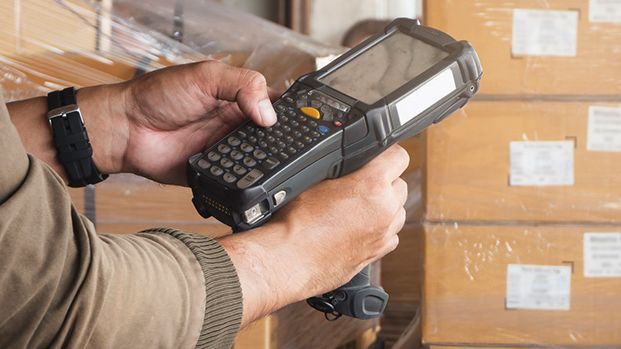Logistics processes connect many participants and resources. It starts with the load carriers and continues with the shippers' loading docks, drivers, trucks and employees who acknowledge receipt of the goods. Freight forwarders who collect a particularly large amount of data, mobile and otherwise, throughout the transport process significantly improve their operations through precise information.
Most logistics tasks are done right where the goods are located by service provider employees. That is why freight forwarders often use portable data terminals – PDTs for short – when managing transports. They are used to perform tasks such as scanning barcodes during loading and unloading and matching package data to the orders in the transport management system (TMS). Barcode scanners used to be prevalent in the industry, but they have recently been replaced by solutions that also run on smartphones. This shift has been driven by powerful new operating systems that support complex applications. From that point on, technology has been used to handle a growing slice of business processes in logistics. This trend is supported by robust enterprise-quality devices such as handheld terminals.
In many areas of transport and logistics process management, mobile apps have opened up new opportunities to use software to simplify processes in and outside the warehouse. These devices automatically capture and share data that employees and customers used to have to call to obtain:
- The current status of an order
- The truck's position
- The driver's driving and rest times
Using this data along with the planned trip, itinerary, and route, the systems can calculate the estimated time of arrival (ETA) and automatically share this data with customers and recipients. At the delivery address, recipients sign directly on the PDT as proof of delivery (POD). The transport order is thus deemed completed and can be billed immediately.
In addition to generating process data, portable data terminals also provide big benefits in driver communications. Drivers can now document important information right in the process instead of laboriously recording the details on paper and then transferring them to IT systems. This includes pre-departure checks, pallet exchange documentation, cargo securement or entry of complaints about shortages or damages. In addition, PDTs can be used to easily document the transfer of risk, even when the recipient has given permission to drop off the goods unattended.
Capturing as much data as possible right on a mobile device will greatly simplify order administration. Waiting times at unloading points and drivers' working hours are immediately documented digitally. The systems also automatically register the use of toll routes and associate the toll costs with the customer's order right away. In addition, mobile applications have made it easy to register value-added services provided on-site during two-man deliveries: appliance installations, packaging pickups, returns and even disposal services.
In addition, the vehicle telematics control units send back important information for fleet management, such as consumption data, tyre pressure, and brake wear. This allows the systems to issue a report as soon as a truck needs a repair or is due for maintenance, even if it is still on the road. Because this data is collected centrally, it is automatically available for digital reporting. Freight forwarders who want to monitor their total costs per order can now directly associate vehicle wear and tear, toll costs, and actual fuel consumption for a given trip with the freight forwarding orders. This configuration automatically provides much more transparency about revenues from individual orders or individual customers.
Companies can employ digital devices to seamlessly integrate their field staff into a digital end-to-end process. They gain the ability to collect all profit-related information without having to re-enter data; much of the information is even provided automatically. In addition, portable data terminals give them the opportunity to actively manage and proactively modify ongoing processes from the office, for example, by making changes to the planned trip and route. They can send information and instructions directly to the drivers and request confirmation on their terminal touchscreen or keypad. This kind of digital process management eliminates the need for time-consuming communication processes – right down to the driver's notification from the truck, which can be fully automated via IVR systems and triggered by either the vehicle position or the pre-calculated ETA. In the meantime, much of the data can be captured as a workflow in web apps using the web browser installed on the mobile device. This is particularly helpful for transports arranged on the spot market or done by subcontractors who have no fixed contract with the freight forwarder.



